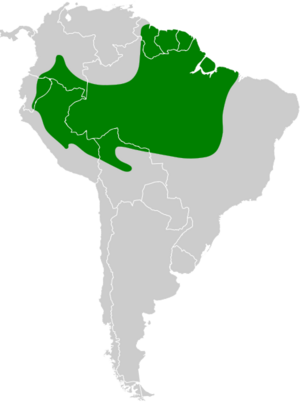Rufous-rumped foliage-gleaner facts for kids
Quick facts for kids Rufous-rumped foliage-gleaner |
|
|---|---|
| Conservation status | |
| Scientific classification | |
| Genus: |
Philydor
|
| Species: |
erythrocercum
|
 |
|
| Synonyms | |
|
Philydor erythrocercus (Pelzeln, 1859) [orthographic error] |
|
The rufous-rumped foliage-gleaner (Philydor erythrocercum) is a small, active bird. It belongs to the ovenbird family called Furnariidae. These birds are known for building unique nests. You can find this bird in the forests of South America. It lives in countries like Bolivia, Brazil, Colombia, Ecuador, Peru, French Guiana, Guyana, and Suriname.
Contents
Bird Types: Subspecies
This bird has five different types, called subspecies. Think of them like different versions of the same bird. Scientists use these groups to understand how birds are related.
- P. e. subfulvum
- P. e. ochrogaster
- P. e. lyra
- P. e. suboles
- P. e. erythrocercum
Sometimes, scientists change how they group these birds. This helps them learn more about each type.
What Does the Rufous-Rumped Foliage-Gleaner Look Like?
This bird is about 14 to 17 centimeters (5.5 to 6.7 inches) long. It weighs between 18 and 31 grams (0.6 to 1.1 ounces). Both male and female birds look very similar.
Adult birds have a light, yellowish-brown ring around their eyes. They also have a light stripe above their eyes. Their face is a dark brownish color. The top of their head and back are dark olive-brown. Their rump and the feathers covering their tail are a bright reddish-brown. Their tail is also bright reddish-brown. Their wings are dark olive-brown.
The bird's throat is a pale yellowish color. Its chest and belly are brownish with a hint of olive green. The sides of its body and the feathers under its tail are a slightly darker brownish color. Its eyes are brown. Its beak is dark on top and lighter underneath. Its legs and feet are grayish-green or yellowish-olive.
Young birds have a more orange stripe above their eyes. Their head is more reddish-brown. Their underparts are less yellowish than adult birds.
Different subspecies have slight differences in color. For example, P. e. lyra has a redder back. P. e. ochrogaster has a brighter yellowish stripe above its eye and a more reddish-brown rump.
Where Do Rufous-Rumped Foliage-Gleaners Live?
Most rufous-rumped foliage-gleaners live in the Amazon Basin. Each subspecies lives in a specific area:
- P. e. subfulvum: Lives in the Amazon region from southern Colombia, through eastern Ecuador, and into northern Peru.
- P. e. ochrogaster: Found in the Andes mountains from central Peru south to north-central Bolivia.
- P. e. lyra: Lives in eastern Peru (south of the Amazon River), Brazil (south of the Amazon, east to Maranhão, and south to Mato Grosso), and northern Bolivia.
- P. e. suboles: Found in southeastern Colombia and northwestern Brazil (north of the Amazon River and east to the Rio Negro).
- P. e. erythrocercum: Lives in the Guianas (French Guiana, Guyana, Suriname) and northeastern Brazil (north of the Amazon River and east of the Rio Negro).
These birds live in tropical evergreen forests. This is mainly "terra firme" forest, which means it's on higher, drier ground. They can also be found in "vázea" forest, which floods seasonally. In these areas, they live at elevations up to 1,300 meters (4,300 feet). The P. e. ochrogaster subspecies lives in mountain evergreen forests. These are found at higher elevations, between 800 and 1,650 meters (2,600 to 5,400 feet).
How Rufous-Rumped Foliage-Gleaners Behave
Movement and Home
The rufous-rumped foliage-gleaner stays in the same area all year round. It does not migrate.
What Do They Eat?
This bird eats many different kinds of arthropods, like insects and spiders. It usually hunts alone or in pairs. Often, it joins a mixed-species feeding flock. This is a group of different bird species that hunt for food together.
They mostly look for food in the middle and upper parts of the forest trees. They are very good at pulling prey from dead leaves. They also find food on palm fronds and in tangled vines. They can move in amazing ways to reach their prey.
Reproduction and Nests
Scientists don't know much about how these birds reproduce. In French Guiana, they nest during the dry season. We don't know their nesting season in other places.
One nest was found in a deep hole in a tree stump. It had a soft pad of wood fibers at the bottom. This nest contained two eggs.
What Do They Sound Like?
The song of the rufous-rumped foliage-gleaner is a series of 4 to 6 high notes. It sounds like "chu, chee, chee, chéé, chu," going up and then down. Its calls include a "shrill 'wheeeeyk'" and "cheeyu" or "chak."
Is the Rufous-Rumped Foliage-Gleaner Safe?
The IUCN (International Union for Conservation of Nature) says the rufous-rumped foliage-gleaner is a species of "Least Concern." This means it is not currently in danger of disappearing.
The bird lives across a very large area. Even though we don't know its exact population size, scientists believe it is stable. There are no immediate threats to this bird. It is considered uncommon to fairly common in different parts of its range. It also lives in many protected areas, which helps keep it safe.


